Health Informatics Report: WAN, DNS, Big Data, DICOM and PACS Analysis
VerifiedAdded on 2020/05/16
|11
|2005
|131
Report
AI Summary
This report delves into the core concepts of health informatics, commencing with an exploration of Wide Area Networks (WANs), detailing their architecture, types, and operational significance. It then transitions to the Domain Name System (DNS), elucidating its role in translating domain names to IP addresses and its hierarchical structure. The report further examines Digital Imaging and Communications in Medicine (DICOM) and Picture Archiving and Communication Systems (PACS), highlighting their roles in medical image management and data transmission within healthcare settings. Additionally, it explores the applications of big data in healthcare, including signal processing, data analytics, and cloud computing solutions. The report provides a comprehensive overview of these interconnected technologies and their impact on healthcare practices, supported by relevant references.
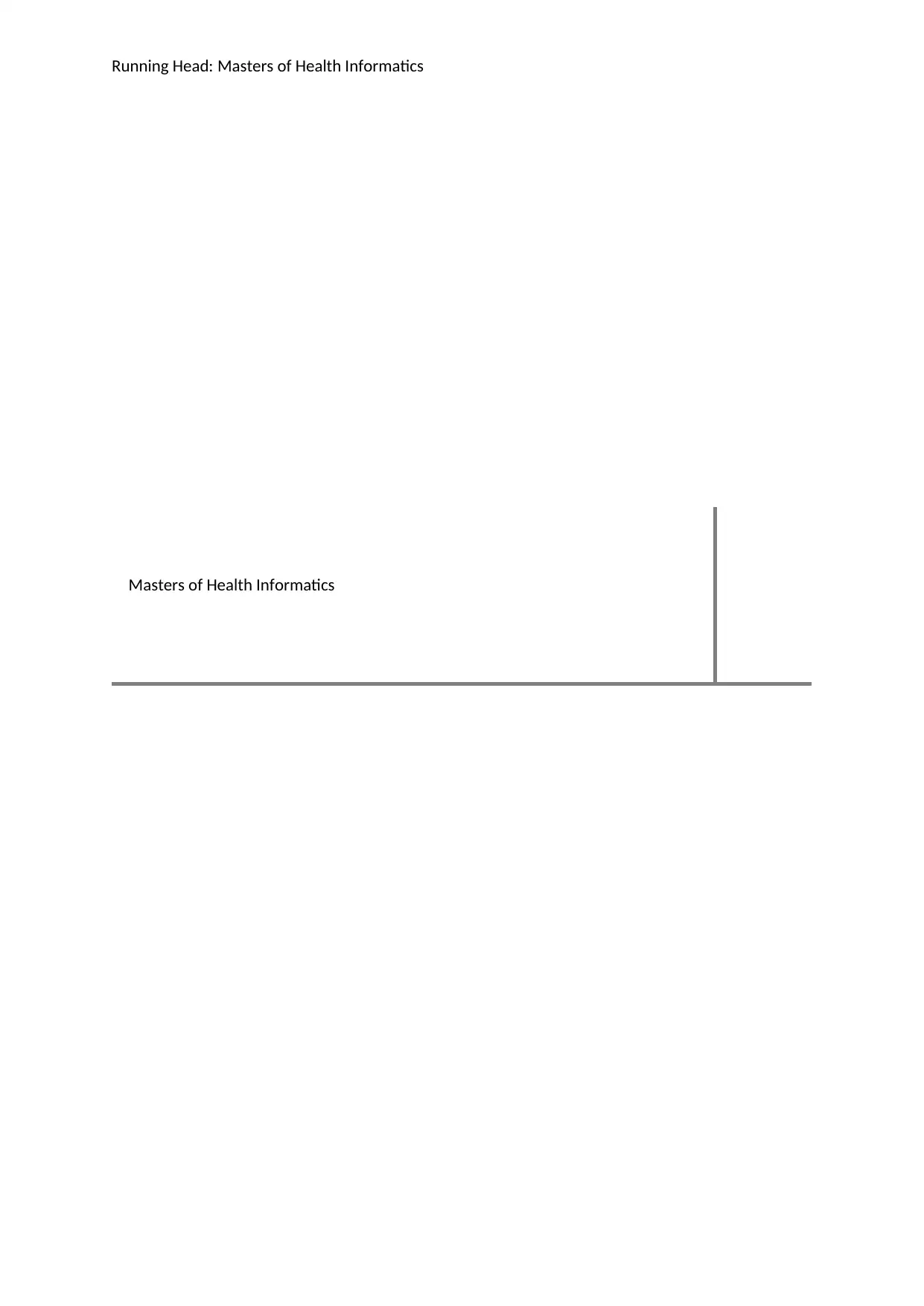
Running Head: Masters of Health Informatics
Masters of Health Informatics
Masters of Health Informatics
Paraphrase This Document
Need a fresh take? Get an instant paraphrase of this document with our AI Paraphraser
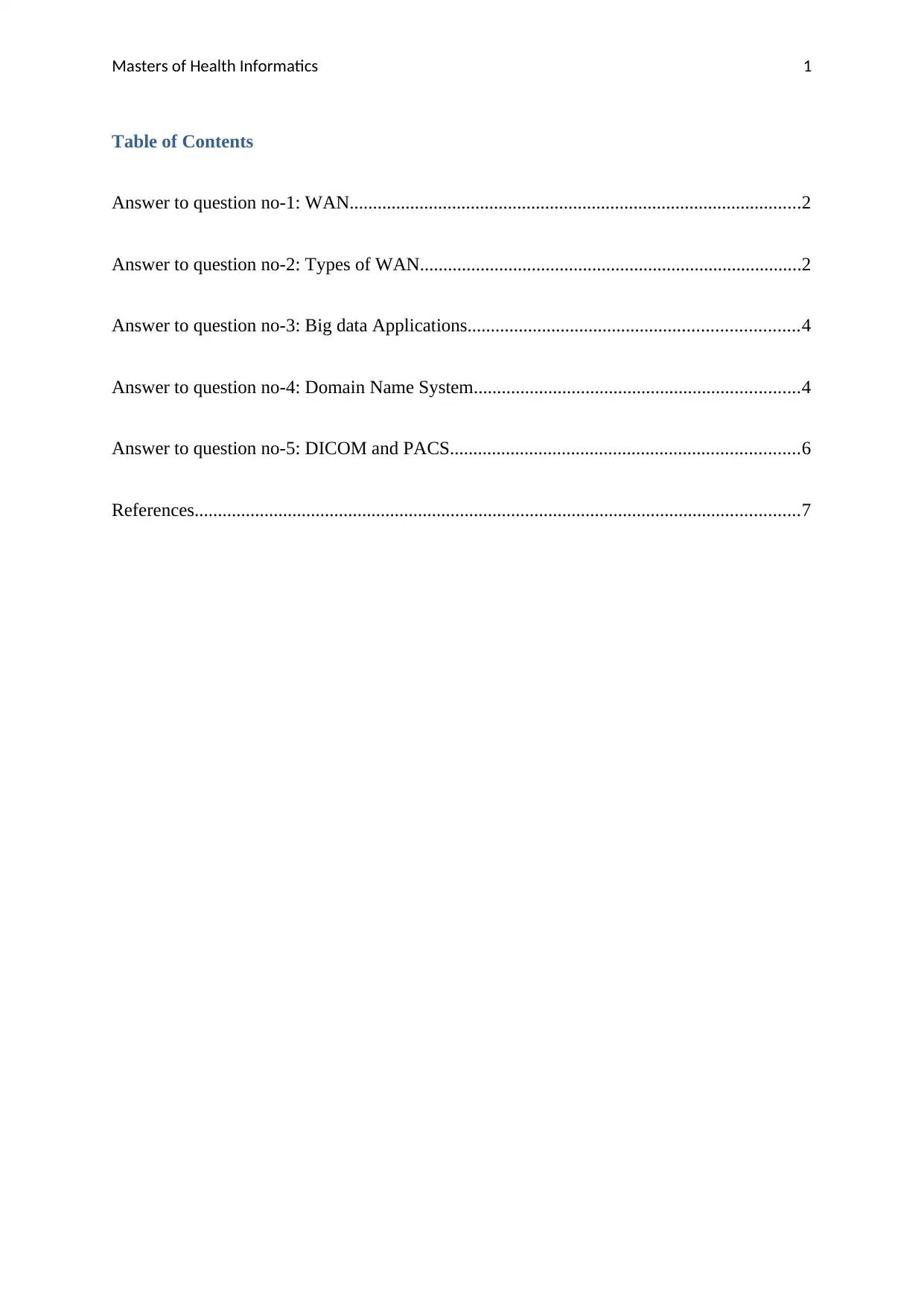
Masters of Health Informatics 1
Table of Contents
Answer to question no-1: WAN.................................................................................................2
Answer to question no-2: Types of WAN..................................................................................2
Answer to question no-3: Big data Applications.......................................................................4
Answer to question no-4: Domain Name System......................................................................4
Answer to question no-5: DICOM and PACS...........................................................................6
References..................................................................................................................................7
Table of Contents
Answer to question no-1: WAN.................................................................................................2
Answer to question no-2: Types of WAN..................................................................................2
Answer to question no-3: Big data Applications.......................................................................4
Answer to question no-4: Domain Name System......................................................................4
Answer to question no-5: DICOM and PACS...........................................................................6
References..................................................................................................................................7
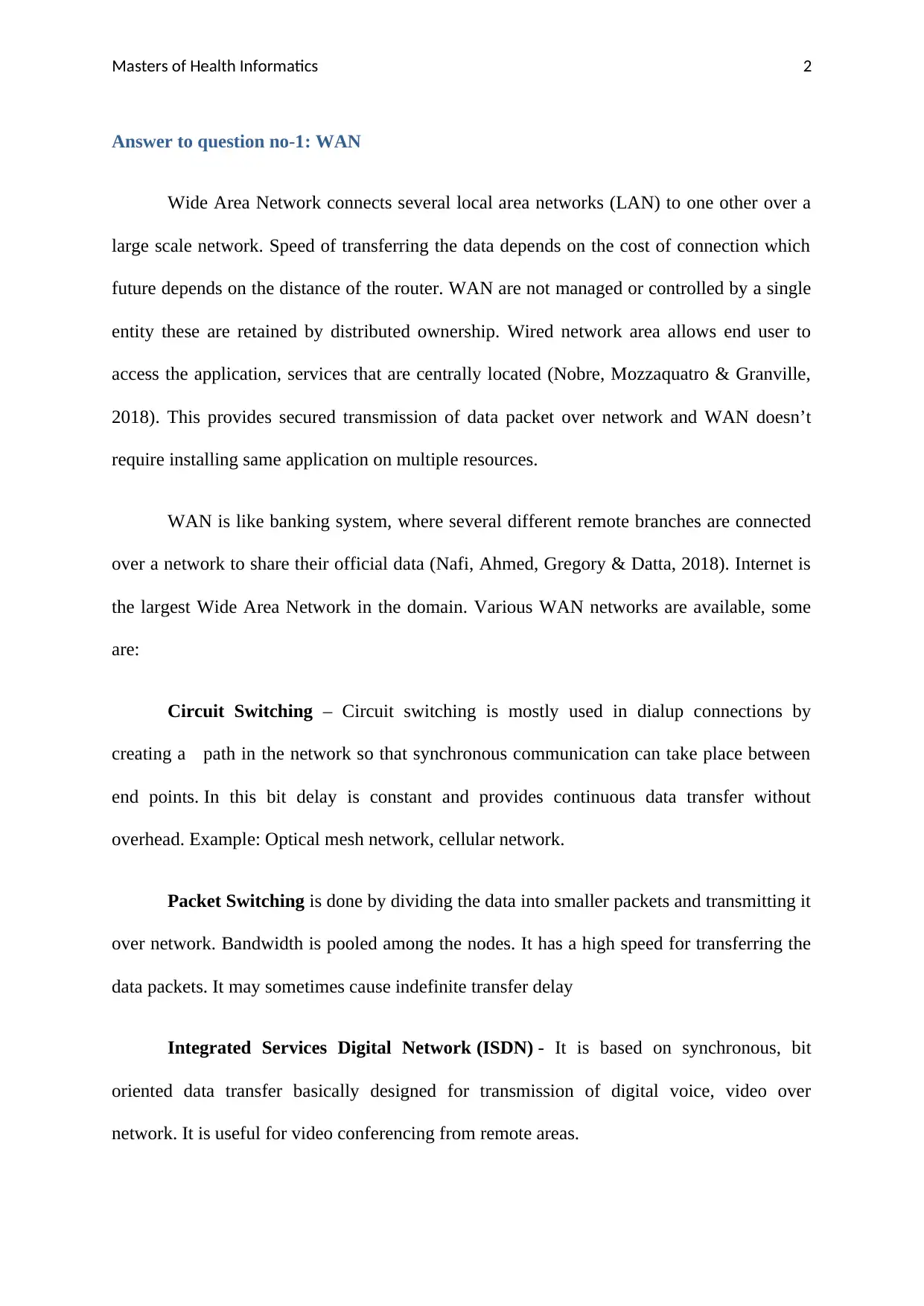
Masters of Health Informatics 2
Answer to question no-1: WAN
Wide Area Network connects several local area networks (LAN) to one other over a
large scale network. Speed of transferring the data depends on the cost of connection which
future depends on the distance of the router. WAN are not managed or controlled by a single
entity these are retained by distributed ownership. Wired network area allows end user to
access the application, services that are centrally located (Nobre, Mozzaquatro & Granville,
2018). This provides secured transmission of data packet over network and WAN doesn’t
require installing same application on multiple resources.
WAN is like banking system, where several different remote branches are connected
over a network to share their official data (Nafi, Ahmed, Gregory & Datta, 2018). Internet is
the largest Wide Area Network in the domain. Various WAN networks are available, some
are:
Circuit Switching – Circuit switching is mostly used in dialup connections by
creating a path in the network so that synchronous communication can take place between
end points. In this bit delay is constant and provides continuous data transfer without
overhead. Example: Optical mesh network, cellular network.
Packet Switching is done by dividing the data into smaller packets and transmitting it
over network. Bandwidth is pooled among the nodes. It has a high speed for transferring the
data packets. It may sometimes cause indefinite transfer delay
Integrated Services Digital Network (ISDN) - It is based on synchronous, bit
oriented data transfer basically designed for transmission of digital voice, video over
network. It is useful for video conferencing from remote areas.
Answer to question no-1: WAN
Wide Area Network connects several local area networks (LAN) to one other over a
large scale network. Speed of transferring the data depends on the cost of connection which
future depends on the distance of the router. WAN are not managed or controlled by a single
entity these are retained by distributed ownership. Wired network area allows end user to
access the application, services that are centrally located (Nobre, Mozzaquatro & Granville,
2018). This provides secured transmission of data packet over network and WAN doesn’t
require installing same application on multiple resources.
WAN is like banking system, where several different remote branches are connected
over a network to share their official data (Nafi, Ahmed, Gregory & Datta, 2018). Internet is
the largest Wide Area Network in the domain. Various WAN networks are available, some
are:
Circuit Switching – Circuit switching is mostly used in dialup connections by
creating a path in the network so that synchronous communication can take place between
end points. In this bit delay is constant and provides continuous data transfer without
overhead. Example: Optical mesh network, cellular network.
Packet Switching is done by dividing the data into smaller packets and transmitting it
over network. Bandwidth is pooled among the nodes. It has a high speed for transferring the
data packets. It may sometimes cause indefinite transfer delay
Integrated Services Digital Network (ISDN) - It is based on synchronous, bit
oriented data transfer basically designed for transmission of digital voice, video over
network. It is useful for video conferencing from remote areas.
⊘ This is a preview!⊘
Do you want full access?
Subscribe today to unlock all pages.

Trusted by 1+ million students worldwide
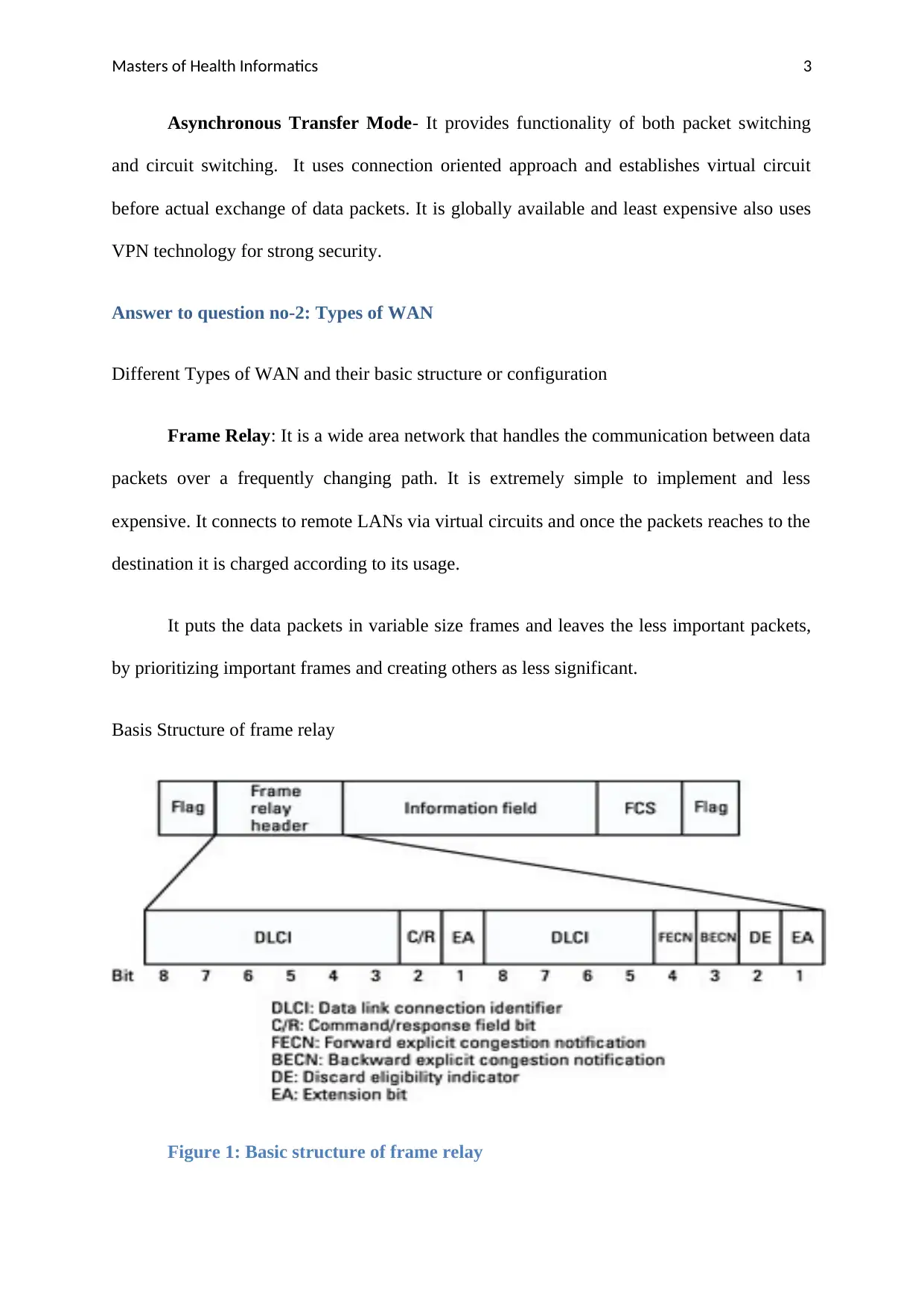
Masters of Health Informatics 3
Asynchronous Transfer Mode- It provides functionality of both packet switching
and circuit switching. It uses connection oriented approach and establishes virtual circuit
before actual exchange of data packets. It is globally available and least expensive also uses
VPN technology for strong security.
Answer to question no-2: Types of WAN
Different Types of WAN and their basic structure or configuration
Frame Relay: It is a wide area network that handles the communication between data
packets over a frequently changing path. It is extremely simple to implement and less
expensive. It connects to remote LANs via virtual circuits and once the packets reaches to the
destination it is charged according to its usage.
It puts the data packets in variable size frames and leaves the less important packets,
by prioritizing important frames and creating others as less significant.
Basis Structure of frame relay
Figure 1: Basic structure of frame relay
Asynchronous Transfer Mode- It provides functionality of both packet switching
and circuit switching. It uses connection oriented approach and establishes virtual circuit
before actual exchange of data packets. It is globally available and least expensive also uses
VPN technology for strong security.
Answer to question no-2: Types of WAN
Different Types of WAN and their basic structure or configuration
Frame Relay: It is a wide area network that handles the communication between data
packets over a frequently changing path. It is extremely simple to implement and less
expensive. It connects to remote LANs via virtual circuits and once the packets reaches to the
destination it is charged according to its usage.
It puts the data packets in variable size frames and leaves the less important packets,
by prioritizing important frames and creating others as less significant.
Basis Structure of frame relay
Figure 1: Basic structure of frame relay
Paraphrase This Document
Need a fresh take? Get an instant paraphrase of this document with our AI Paraphraser
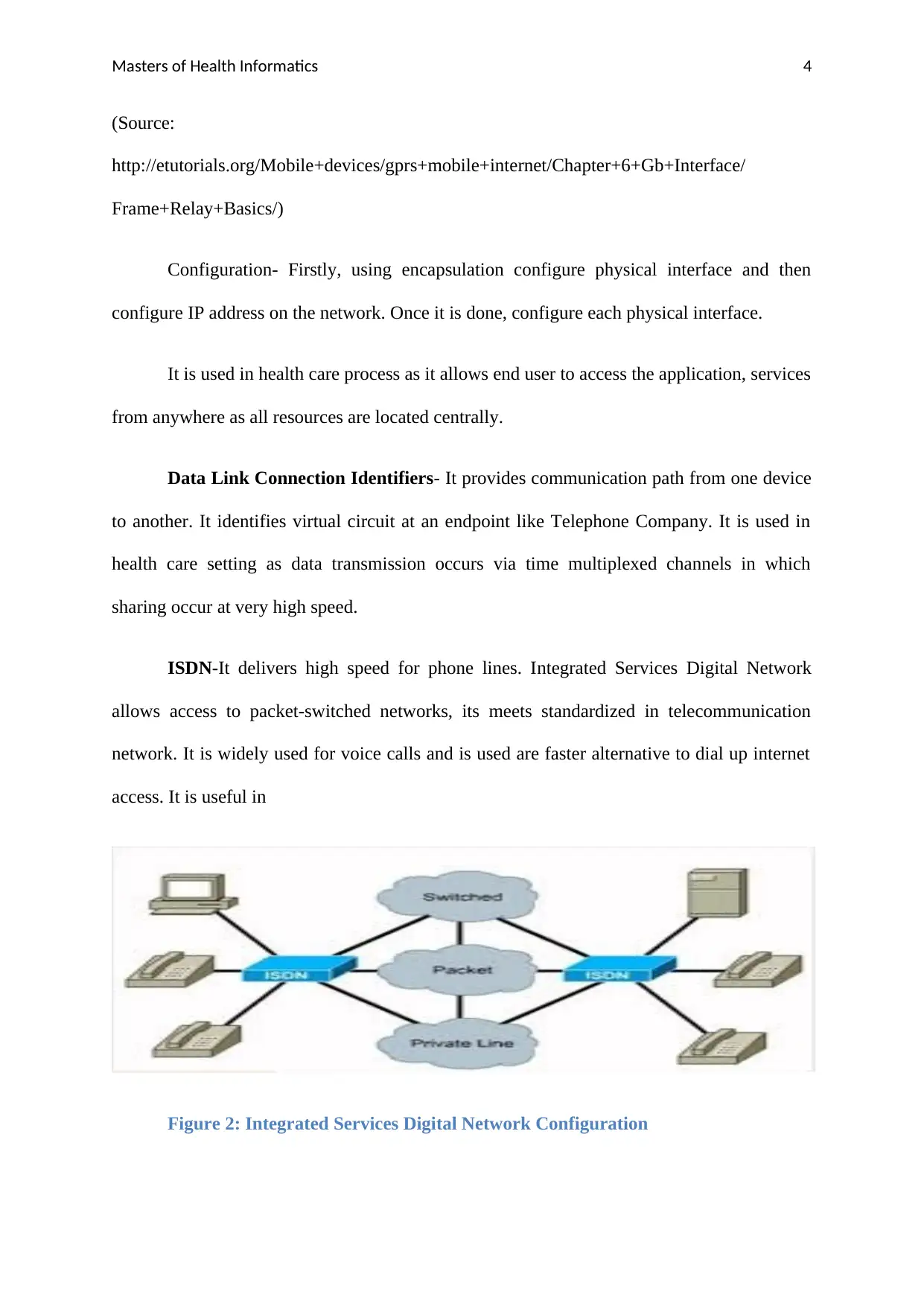
Masters of Health Informatics 4
(Source:
http://etutorials.org/Mobile+devices/gprs+mobile+internet/Chapter+6+Gb+Interface/
Frame+Relay+Basics/)
Configuration- Firstly, using encapsulation configure physical interface and then
configure IP address on the network. Once it is done, configure each physical interface.
It is used in health care process as it allows end user to access the application, services
from anywhere as all resources are located centrally.
Data Link Connection Identifiers- It provides communication path from one device
to another. It identifies virtual circuit at an endpoint like Telephone Company. It is used in
health care setting as data transmission occurs via time multiplexed channels in which
sharing occur at very high speed.
ISDN-It delivers high speed for phone lines. Integrated Services Digital Network
allows access to packet-switched networks, its meets standardized in telecommunication
network. It is widely used for voice calls and is used are faster alternative to dial up internet
access. It is useful in
Figure 2: Integrated Services Digital Network Configuration
(Source:
http://etutorials.org/Mobile+devices/gprs+mobile+internet/Chapter+6+Gb+Interface/
Frame+Relay+Basics/)
Configuration- Firstly, using encapsulation configure physical interface and then
configure IP address on the network. Once it is done, configure each physical interface.
It is used in health care process as it allows end user to access the application, services
from anywhere as all resources are located centrally.
Data Link Connection Identifiers- It provides communication path from one device
to another. It identifies virtual circuit at an endpoint like Telephone Company. It is used in
health care setting as data transmission occurs via time multiplexed channels in which
sharing occur at very high speed.
ISDN-It delivers high speed for phone lines. Integrated Services Digital Network
allows access to packet-switched networks, its meets standardized in telecommunication
network. It is widely used for voice calls and is used are faster alternative to dial up internet
access. It is useful in
Figure 2: Integrated Services Digital Network Configuration
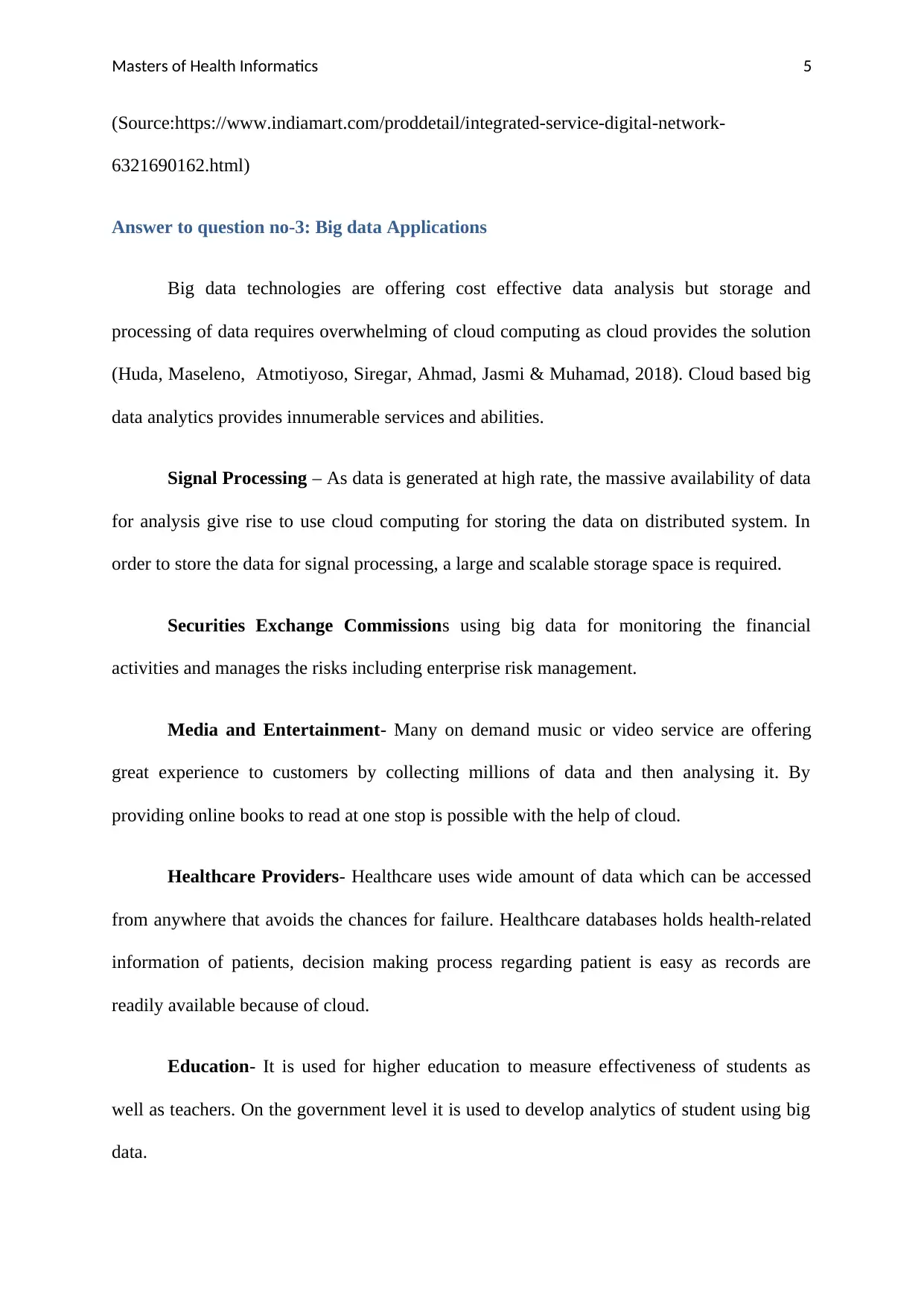
Masters of Health Informatics 5
(Source:https://www.indiamart.com/proddetail/integrated-service-digital-network-
6321690162.html)
Answer to question no-3: Big data Applications
Big data technologies are offering cost effective data analysis but storage and
processing of data requires overwhelming of cloud computing as cloud provides the solution
(Huda, Maseleno, Atmotiyoso, Siregar, Ahmad, Jasmi & Muhamad, 2018). Cloud based big
data analytics provides innumerable services and abilities.
Signal Processing – As data is generated at high rate, the massive availability of data
for analysis give rise to use cloud computing for storing the data on distributed system. In
order to store the data for signal processing, a large and scalable storage space is required.
Securities Exchange Commissions using big data for monitoring the financial
activities and manages the risks including enterprise risk management.
Media and Entertainment- Many on demand music or video service are offering
great experience to customers by collecting millions of data and then analysing it. By
providing online books to read at one stop is possible with the help of cloud.
Healthcare Providers- Healthcare uses wide amount of data which can be accessed
from anywhere that avoids the chances for failure. Healthcare databases holds health-related
information of patients, decision making process regarding patient is easy as records are
readily available because of cloud.
Education- It is used for higher education to measure effectiveness of students as
well as teachers. On the government level it is used to develop analytics of student using big
data.
(Source:https://www.indiamart.com/proddetail/integrated-service-digital-network-
6321690162.html)
Answer to question no-3: Big data Applications
Big data technologies are offering cost effective data analysis but storage and
processing of data requires overwhelming of cloud computing as cloud provides the solution
(Huda, Maseleno, Atmotiyoso, Siregar, Ahmad, Jasmi & Muhamad, 2018). Cloud based big
data analytics provides innumerable services and abilities.
Signal Processing – As data is generated at high rate, the massive availability of data
for analysis give rise to use cloud computing for storing the data on distributed system. In
order to store the data for signal processing, a large and scalable storage space is required.
Securities Exchange Commissions using big data for monitoring the financial
activities and manages the risks including enterprise risk management.
Media and Entertainment- Many on demand music or video service are offering
great experience to customers by collecting millions of data and then analysing it. By
providing online books to read at one stop is possible with the help of cloud.
Healthcare Providers- Healthcare uses wide amount of data which can be accessed
from anywhere that avoids the chances for failure. Healthcare databases holds health-related
information of patients, decision making process regarding patient is easy as records are
readily available because of cloud.
Education- It is used for higher education to measure effectiveness of students as
well as teachers. On the government level it is used to develop analytics of student using big
data.
⊘ This is a preview!⊘
Do you want full access?
Subscribe today to unlock all pages.

Trusted by 1+ million students worldwide
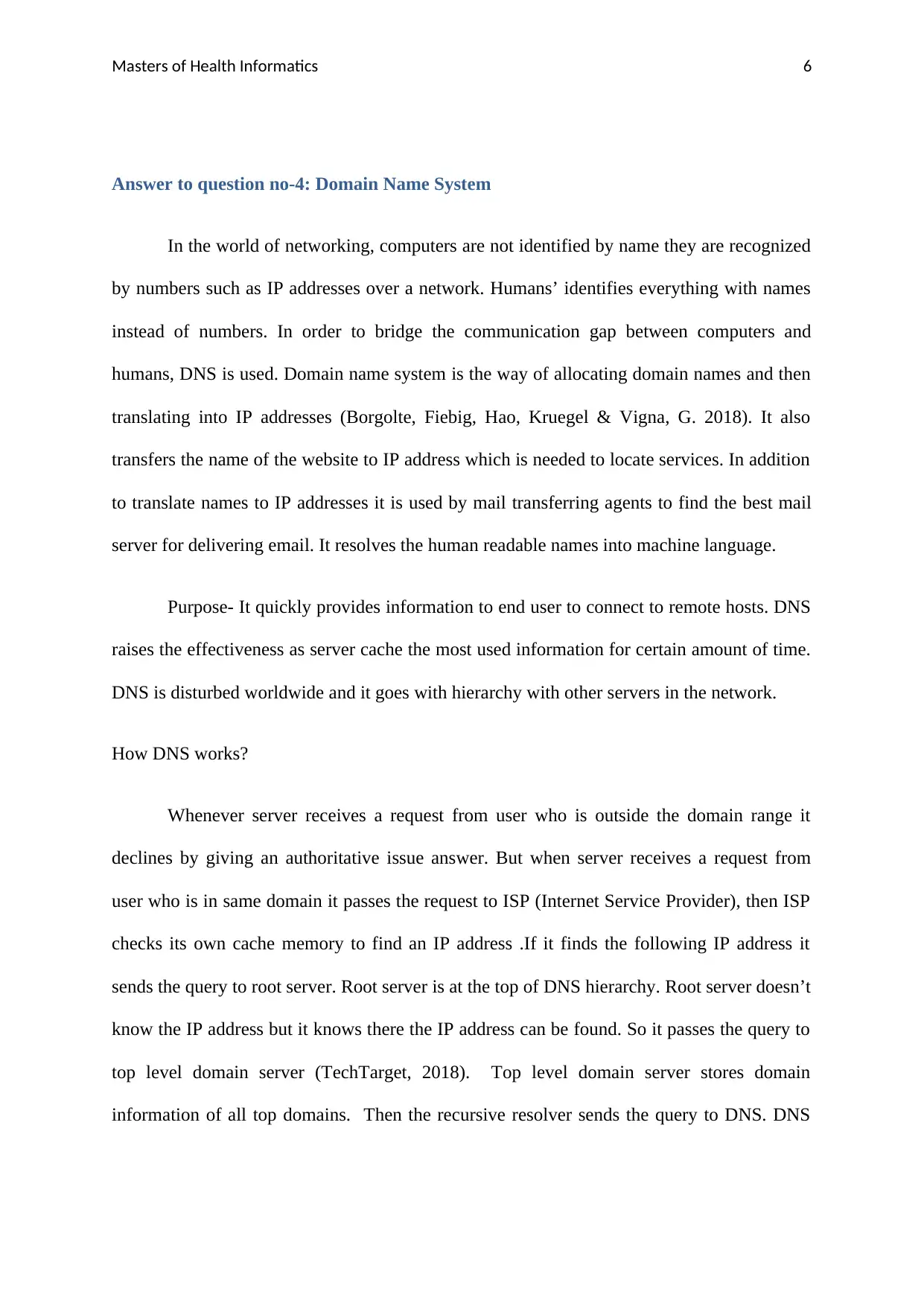
Masters of Health Informatics 6
Answer to question no-4: Domain Name System
In the world of networking, computers are not identified by name they are recognized
by numbers such as IP addresses over a network. Humans’ identifies everything with names
instead of numbers. In order to bridge the communication gap between computers and
humans, DNS is used. Domain name system is the way of allocating domain names and then
translating into IP addresses (Borgolte, Fiebig, Hao, Kruegel & Vigna, G. 2018). It also
transfers the name of the website to IP address which is needed to locate services. In addition
to translate names to IP addresses it is used by mail transferring agents to find the best mail
server for delivering email. It resolves the human readable names into machine language.
Purpose- It quickly provides information to end user to connect to remote hosts. DNS
raises the effectiveness as server cache the most used information for certain amount of time.
DNS is disturbed worldwide and it goes with hierarchy with other servers in the network.
How DNS works?
Whenever server receives a request from user who is outside the domain range it
declines by giving an authoritative issue answer. But when server receives a request from
user who is in same domain it passes the request to ISP (Internet Service Provider), then ISP
checks its own cache memory to find an IP address .If it finds the following IP address it
sends the query to root server. Root server is at the top of DNS hierarchy. Root server doesn’t
know the IP address but it knows there the IP address can be found. So it passes the query to
top level domain server (TechTarget, 2018). Top level domain server stores domain
information of all top domains. Then the recursive resolver sends the query to DNS. DNS
Answer to question no-4: Domain Name System
In the world of networking, computers are not identified by name they are recognized
by numbers such as IP addresses over a network. Humans’ identifies everything with names
instead of numbers. In order to bridge the communication gap between computers and
humans, DNS is used. Domain name system is the way of allocating domain names and then
translating into IP addresses (Borgolte, Fiebig, Hao, Kruegel & Vigna, G. 2018). It also
transfers the name of the website to IP address which is needed to locate services. In addition
to translate names to IP addresses it is used by mail transferring agents to find the best mail
server for delivering email. It resolves the human readable names into machine language.
Purpose- It quickly provides information to end user to connect to remote hosts. DNS
raises the effectiveness as server cache the most used information for certain amount of time.
DNS is disturbed worldwide and it goes with hierarchy with other servers in the network.
How DNS works?
Whenever server receives a request from user who is outside the domain range it
declines by giving an authoritative issue answer. But when server receives a request from
user who is in same domain it passes the request to ISP (Internet Service Provider), then ISP
checks its own cache memory to find an IP address .If it finds the following IP address it
sends the query to root server. Root server is at the top of DNS hierarchy. Root server doesn’t
know the IP address but it knows there the IP address can be found. So it passes the query to
top level domain server (TechTarget, 2018). Top level domain server stores domain
information of all top domains. Then the recursive resolver sends the query to DNS. DNS
Paraphrase This Document
Need a fresh take? Get an instant paraphrase of this document with our AI Paraphraser
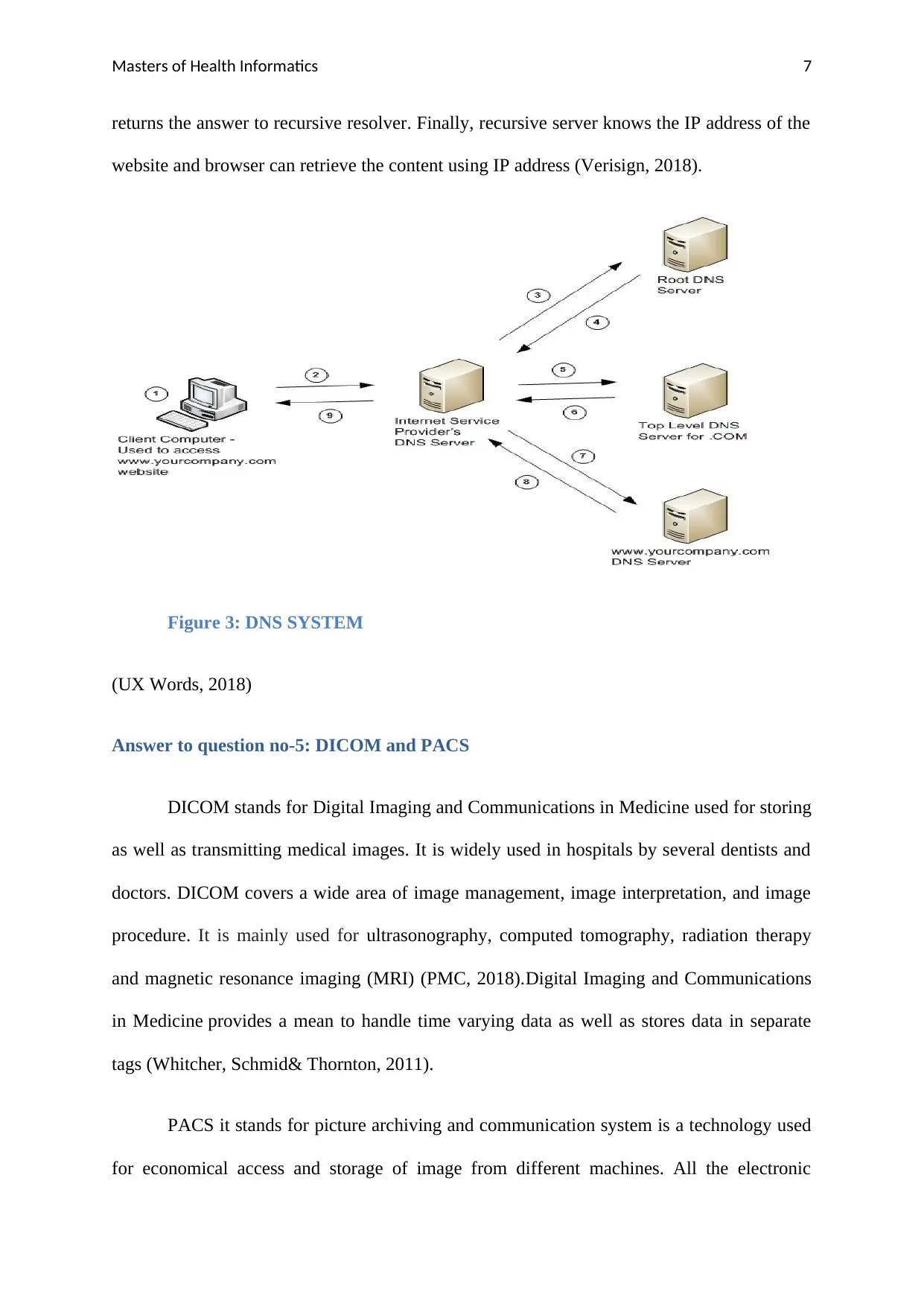
Masters of Health Informatics 7
returns the answer to recursive resolver. Finally, recursive server knows the IP address of the
website and browser can retrieve the content using IP address (Verisign, 2018).
Figure 3: DNS SYSTEM
(UX Words, 2018)
Answer to question no-5: DICOM and PACS
DICOM stands for Digital Imaging and Communications in Medicine used for storing
as well as transmitting medical images. It is widely used in hospitals by several dentists and
doctors. DICOM covers a wide area of image management, image interpretation, and image
procedure. It is mainly used for ultrasonography, computed tomography, radiation therapy
and magnetic resonance imaging (MRI) (PMC, 2018).Digital Imaging and Communications
in Medicine provides a mean to handle time varying data as well as stores data in separate
tags (Whitcher, Schmid& Thornton, 2011).
PACS it stands for picture archiving and communication system is a technology used
for economical access and storage of image from different machines. All the electronic
returns the answer to recursive resolver. Finally, recursive server knows the IP address of the
website and browser can retrieve the content using IP address (Verisign, 2018).
Figure 3: DNS SYSTEM
(UX Words, 2018)
Answer to question no-5: DICOM and PACS
DICOM stands for Digital Imaging and Communications in Medicine used for storing
as well as transmitting medical images. It is widely used in hospitals by several dentists and
doctors. DICOM covers a wide area of image management, image interpretation, and image
procedure. It is mainly used for ultrasonography, computed tomography, radiation therapy
and magnetic resonance imaging (MRI) (PMC, 2018).Digital Imaging and Communications
in Medicine provides a mean to handle time varying data as well as stores data in separate
tags (Whitcher, Schmid& Thornton, 2011).
PACS it stands for picture archiving and communication system is a technology used
for economical access and storage of image from different machines. All the electronic
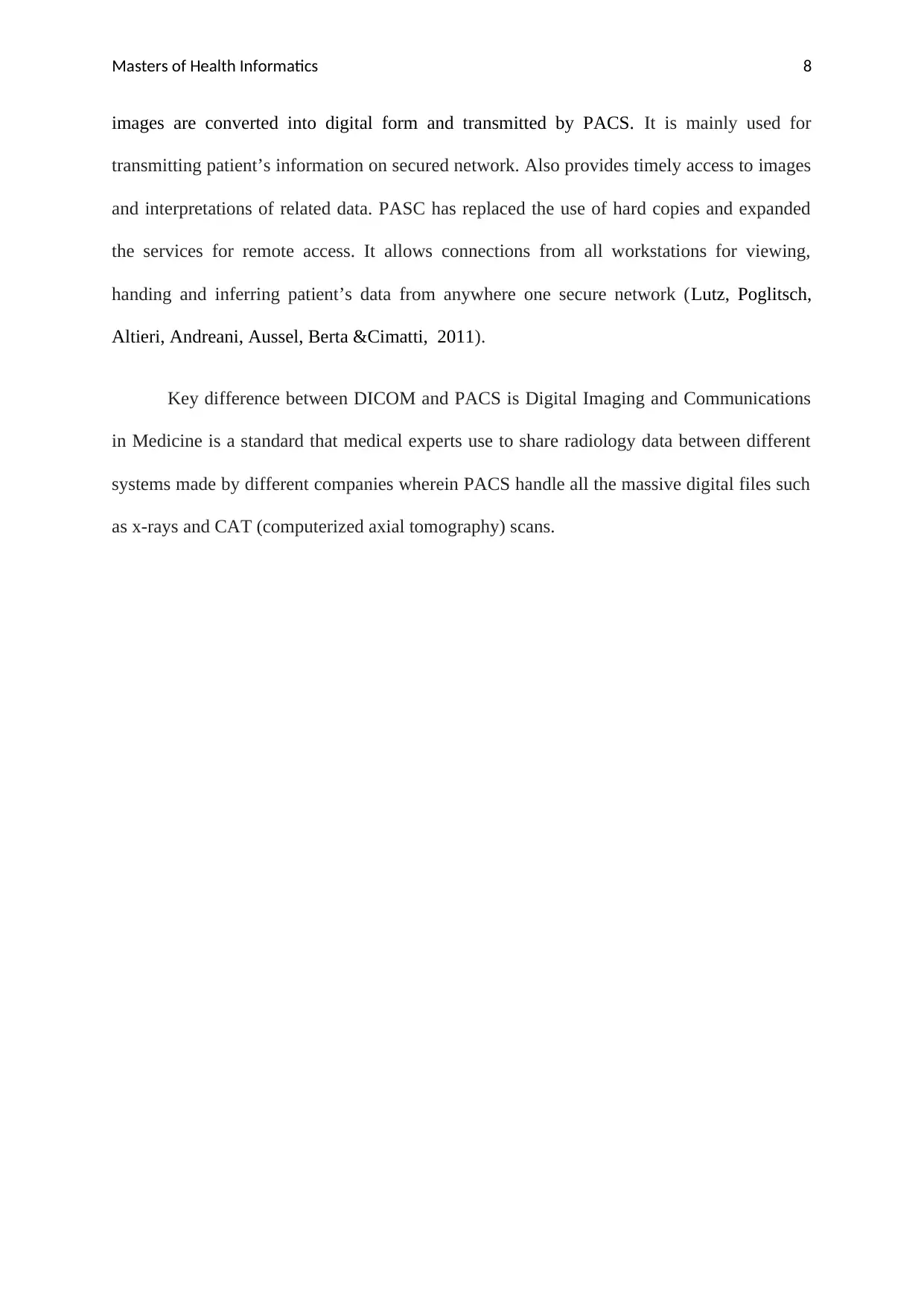
Masters of Health Informatics 8
images are converted into digital form and transmitted by PACS. It is mainly used for
transmitting patient’s information on secured network. Also provides timely access to images
and interpretations of related data. PASC has replaced the use of hard copies and expanded
the services for remote access. It allows connections from all workstations for viewing,
handing and inferring patient’s data from anywhere one secure network (Lutz, Poglitsch,
Altieri, Andreani, Aussel, Berta &Cimatti, 2011).
Key difference between DICOM and PACS is Digital Imaging and Communications
in Medicine is a standard that medical experts use to share radiology data between different
systems made by different companies wherein PACS handle all the massive digital files such
as x-rays and CAT (computerized axial tomography) scans.
images are converted into digital form and transmitted by PACS. It is mainly used for
transmitting patient’s information on secured network. Also provides timely access to images
and interpretations of related data. PASC has replaced the use of hard copies and expanded
the services for remote access. It allows connections from all workstations for viewing,
handing and inferring patient’s data from anywhere one secure network (Lutz, Poglitsch,
Altieri, Andreani, Aussel, Berta &Cimatti, 2011).
Key difference between DICOM and PACS is Digital Imaging and Communications
in Medicine is a standard that medical experts use to share radiology data between different
systems made by different companies wherein PACS handle all the massive digital files such
as x-rays and CAT (computerized axial tomography) scans.
⊘ This is a preview!⊘
Do you want full access?
Subscribe today to unlock all pages.

Trusted by 1+ million students worldwide
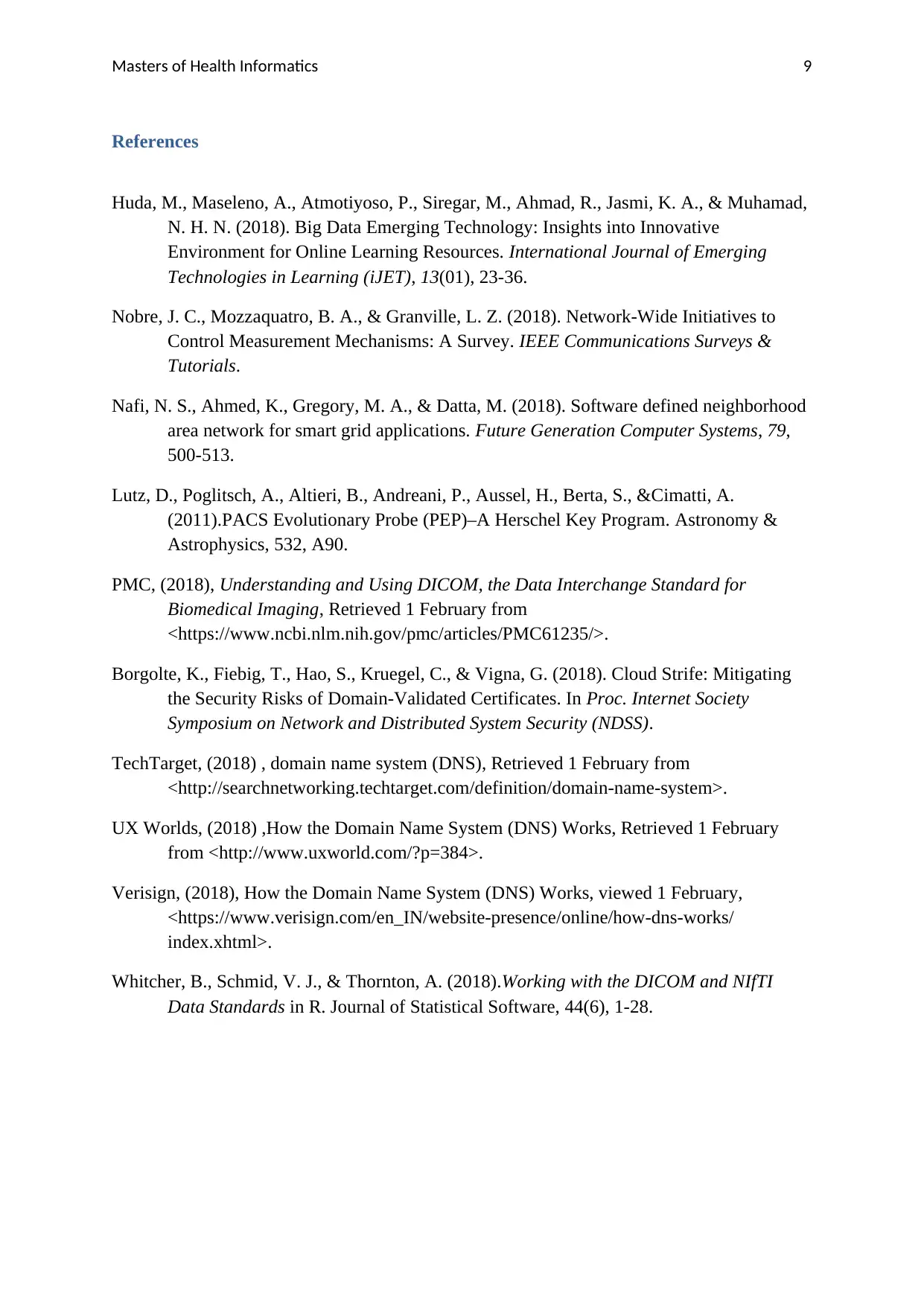
Masters of Health Informatics 9
References
Huda, M., Maseleno, A., Atmotiyoso, P., Siregar, M., Ahmad, R., Jasmi, K. A., & Muhamad,
N. H. N. (2018). Big Data Emerging Technology: Insights into Innovative
Environment for Online Learning Resources. International Journal of Emerging
Technologies in Learning (iJET), 13(01), 23-36.
Nobre, J. C., Mozzaquatro, B. A., & Granville, L. Z. (2018). Network-Wide Initiatives to
Control Measurement Mechanisms: A Survey. IEEE Communications Surveys &
Tutorials.
Nafi, N. S., Ahmed, K., Gregory, M. A., & Datta, M. (2018). Software defined neighborhood
area network for smart grid applications. Future Generation Computer Systems, 79,
500-513.
Lutz, D., Poglitsch, A., Altieri, B., Andreani, P., Aussel, H., Berta, S., &Cimatti, A.
(2011).PACS Evolutionary Probe (PEP)–A Herschel Key Program. Astronomy &
Astrophysics, 532, A90.
PMC, (2018), Understanding and Using DICOM, the Data Interchange Standard for
Biomedical Imaging, Retrieved 1 February from
<https://www.ncbi.nlm.nih.gov/pmc/articles/PMC61235/>.
Borgolte, K., Fiebig, T., Hao, S., Kruegel, C., & Vigna, G. (2018). Cloud Strife: Mitigating
the Security Risks of Domain-Validated Certificates. In Proc. Internet Society
Symposium on Network and Distributed System Security (NDSS).
TechTarget, (2018) , domain name system (DNS), Retrieved 1 February from
<http://searchnetworking.techtarget.com/definition/domain-name-system>.
UX Worlds, (2018) ,How the Domain Name System (DNS) Works, Retrieved 1 February
from <http://www.uxworld.com/?p=384>.
Verisign, (2018), How the Domain Name System (DNS) Works, viewed 1 February,
<https://www.verisign.com/en_IN/website-presence/online/how-dns-works/
index.xhtml>.
Whitcher, B., Schmid, V. J., & Thornton, A. (2018).Working with the DICOM and NIfTI
Data Standards in R. Journal of Statistical Software, 44(6), 1-28.
References
Huda, M., Maseleno, A., Atmotiyoso, P., Siregar, M., Ahmad, R., Jasmi, K. A., & Muhamad,
N. H. N. (2018). Big Data Emerging Technology: Insights into Innovative
Environment for Online Learning Resources. International Journal of Emerging
Technologies in Learning (iJET), 13(01), 23-36.
Nobre, J. C., Mozzaquatro, B. A., & Granville, L. Z. (2018). Network-Wide Initiatives to
Control Measurement Mechanisms: A Survey. IEEE Communications Surveys &
Tutorials.
Nafi, N. S., Ahmed, K., Gregory, M. A., & Datta, M. (2018). Software defined neighborhood
area network for smart grid applications. Future Generation Computer Systems, 79,
500-513.
Lutz, D., Poglitsch, A., Altieri, B., Andreani, P., Aussel, H., Berta, S., &Cimatti, A.
(2011).PACS Evolutionary Probe (PEP)–A Herschel Key Program. Astronomy &
Astrophysics, 532, A90.
PMC, (2018), Understanding and Using DICOM, the Data Interchange Standard for
Biomedical Imaging, Retrieved 1 February from
<https://www.ncbi.nlm.nih.gov/pmc/articles/PMC61235/>.
Borgolte, K., Fiebig, T., Hao, S., Kruegel, C., & Vigna, G. (2018). Cloud Strife: Mitigating
the Security Risks of Domain-Validated Certificates. In Proc. Internet Society
Symposium on Network and Distributed System Security (NDSS).
TechTarget, (2018) , domain name system (DNS), Retrieved 1 February from
<http://searchnetworking.techtarget.com/definition/domain-name-system>.
UX Worlds, (2018) ,How the Domain Name System (DNS) Works, Retrieved 1 February
from <http://www.uxworld.com/?p=384>.
Verisign, (2018), How the Domain Name System (DNS) Works, viewed 1 February,
<https://www.verisign.com/en_IN/website-presence/online/how-dns-works/
index.xhtml>.
Whitcher, B., Schmid, V. J., & Thornton, A. (2018).Working with the DICOM and NIfTI
Data Standards in R. Journal of Statistical Software, 44(6), 1-28.
Paraphrase This Document
Need a fresh take? Get an instant paraphrase of this document with our AI Paraphraser

Masters of Health Informatics 10
1 out of 11
Related Documents
Your All-in-One AI-Powered Toolkit for Academic Success.
+13062052269
info@desklib.com
Available 24*7 on WhatsApp / Email
![[object Object]](/_next/static/media/star-bottom.7253800d.svg)
Unlock your academic potential
Copyright © 2020–2025 A2Z Services. All Rights Reserved. Developed and managed by ZUCOL.




